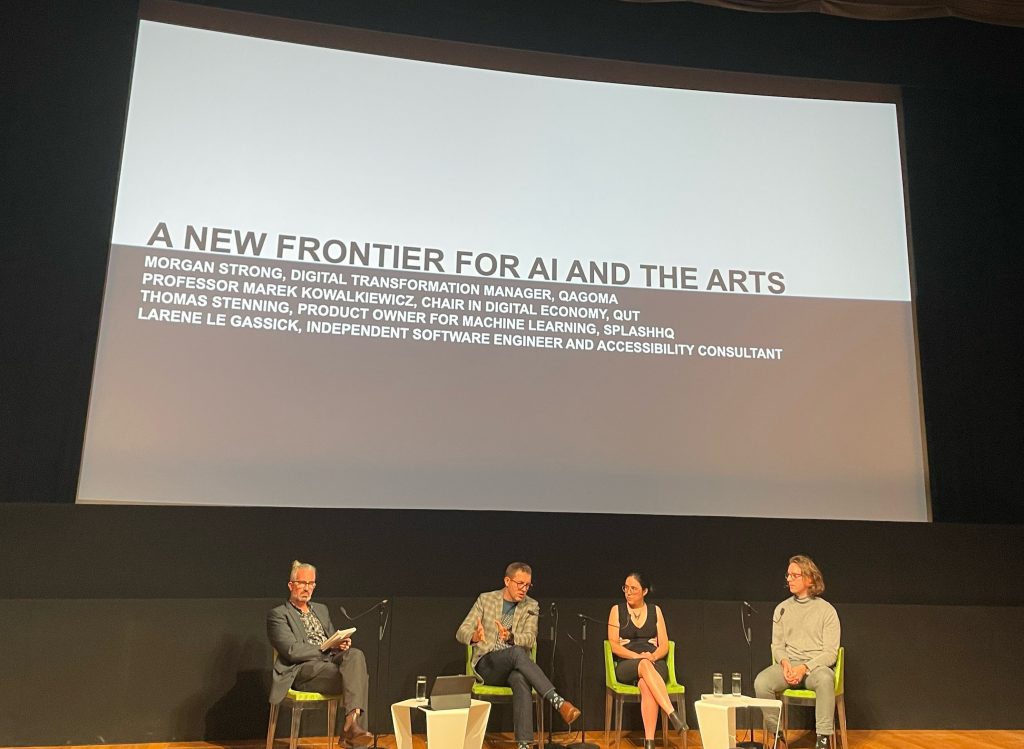Gaia Resources works to bring technology solutions to bear where there is a problem to be solved for the benefit of the community. This means our work in the GLAM (Galleries, Libraries, Art & Museums) sector is often about services that allow the various resources and assets of these institutions to be made available to the public.
One of the things that I find most transcendent about experiencing and engaging with art is its ability to create a connection between viewers and participants. And one of the very reasons why I would like to talk about it, is because it shouldn’t need to be an exclusive right, available only to those whom the luxury is accessible. Some of our team member’s favourite projects are those which provide them with an opportunity to bring their area of passion into the public’s eye, for all to engage with it.
As part of our ongoing involvement with the gallery, I was recently able to attend a panel discussion and exhibition held at the Gallery of Modern Art (GOMA), in Stanley place. The panel topic was ‘A New Frontier for AI and the Arts’, which, given my interest in technology and the Arts, was an amazing opportunity. I also had the chance to view the current Exhibition ‘Chiharu Shiota: The Soul Trembles’ in the evening light, and was blown away at both the technical challenge in such a complex exhibition and the intense and overwhelming experience that was the installation in the very first room.
The panel itself was chaired by QAGOMA Digital Transformation Manager Morgan Strong, and featured Professor Marek Kowalkiewicz (QUT Chair in Digital Economy); Thomas Stenning (Product Owner for Machine Learning at SplashHQ); and Larene Le Gassick (Independent Software Engineer and Accessibility Consultant). The panellists all brought together different perspectives and considerations for the discussions on ‘merging of AI with cultural practice’.
Discussions touched on a range of areas in the brief time available, including the question of if we consider the outputs of AI art generators such as DALL-E 2 to be truly creative in their own right? And if so, is the artist the person providing the prompt for creation, or does it include the writers of the algorithms behind the system? Perhaps AI will be considered as instead another tool that allows artists to visualise, discover and explore across mediums and domains without requiring the years of practise to develop each of the associated technical skills. If that is the case, does that allow a new type of artist to find their place? Technology is one tool that can bring years of training and education and instead provide a more accessible outlet for creative thought that can be shared and used by a new type of artist. Bringing access to existing cultural assets is one thing, providing both that and the resources to allow those who may typically struggle to create art using traditional methods is another. Whether it be marginalised groups to whom the years of typically unpaid labour perfecting a specific technique may be a barrier, or someone to whom the application of physical brush to canvas is a challenge, technology provides new means to create and engage with art.
While each panellist had their own perspective, the discussion provided insights into the potential (and potential challenges) that may be found through the use of AI in the Arts.
The panel was followed by a short presentation from QAGOMA’s Digital Resident, Kate Thompson (Associate Professor of Digital Pedagogies, QUT), presenting some highlights from her recent research into the utilisation of technology by audiences at the Gallery. It was fascinating to see how that gallery is using technology to allow visitors more varied and informed engagement with exhibitions.

Collections online allows for high quality digital images, with functionality from a simple zoom to sliders displaying the before and after images from restorations.
It was marvellous to hear about further work being done at QAGOMA as part of their Digital Transformation program. We wrote late last year about our work on rebuilding their Collections Online platform. Since then monthly traffic to the site has increased fivefold. Given our passion for bringing the assets of our institutions into the public eye, this is an amazing motivation for us to continue this work.
If you’re interested in how your organisation’s content can be brought to the public, please get in touch via email or get in touch on our socials: Facebook, Twitter or LinkedIn
Sophie


Comments are closed.